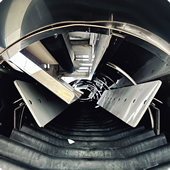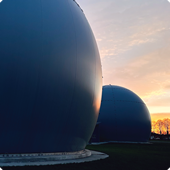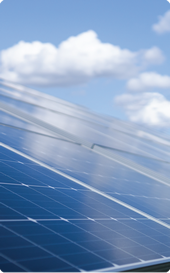
Biosolids dryer conveyor |

Duosphere biogas storage |
|
Biosolids Dryer
Onondaga County and the Department of Water Environment Protection (WEP) are advancing their goals of cost savings and sustainability with a new project to install a drying system at the Metropolitan Syracuse Wastewater Treatment Plant (Metro) in Syracuse. Biosolids, the organic solid materials filtered out of wastewater, are managed at the Metro Solids Management Facility, which has been operational since 1959. This facility handles solids disposal for the Metro plant and four other WEP treatment plants.
Biosolids are dewatered using centrifuges, similar to a washing machine's spin cycle, to remove some moisture before they are transported to landfills. Metro produces approximately 37,000 wet tons of dewatered biosolids annually, with about 70% of that weight being residual water not removed by the centrifuges. This high-water content increases transportation and disposal costs. By investing in advanced drying technology, WEP aims to significantly reduce the water content to just 10%, leading to substantial savings in transportation and disposal fees. Additionally, the drying process improves the quality of the biosolids, allowing for more versatile reuse options, including soil applications.
Digester Improvements
As part of the treatment process, Metro employs anaerobic digestion, where bacteria feed on organic matter in the wastewater. This process produces biogas, primarily composed of methane. Digesters, the equipment used for anaerobic digestion, are often recognizable by the torch on top, which indicates the burning off of excess biogas. The Digester Improvement Project aims to upgrade and rehabilitate all major digestion equipment, with a goal to increase biogas production by installing a new cover on one of the digesters. The addition of two new Duospheres to store biogas maximizes WEP's ability to reuse the biogas to heat and power parts of the Metro facility.
|







